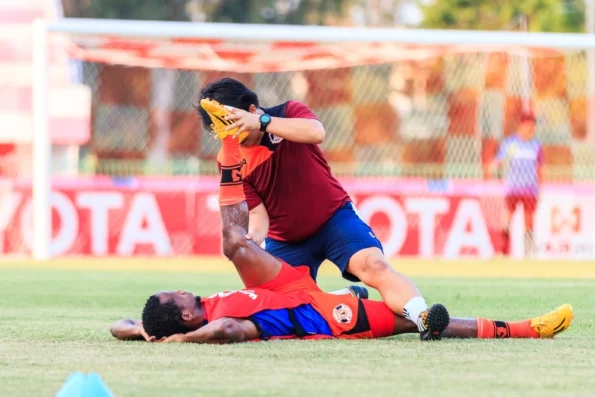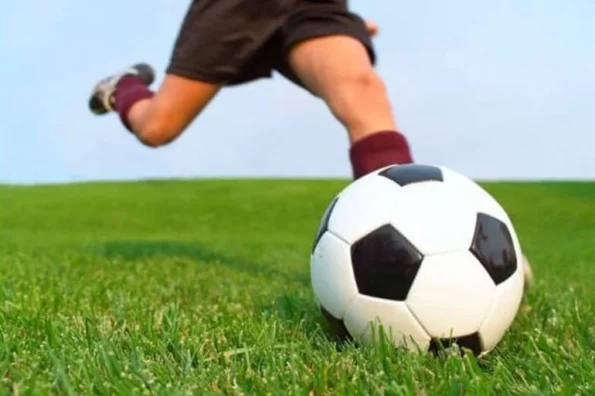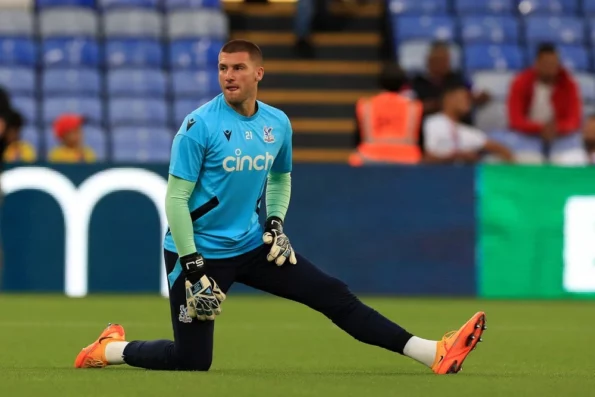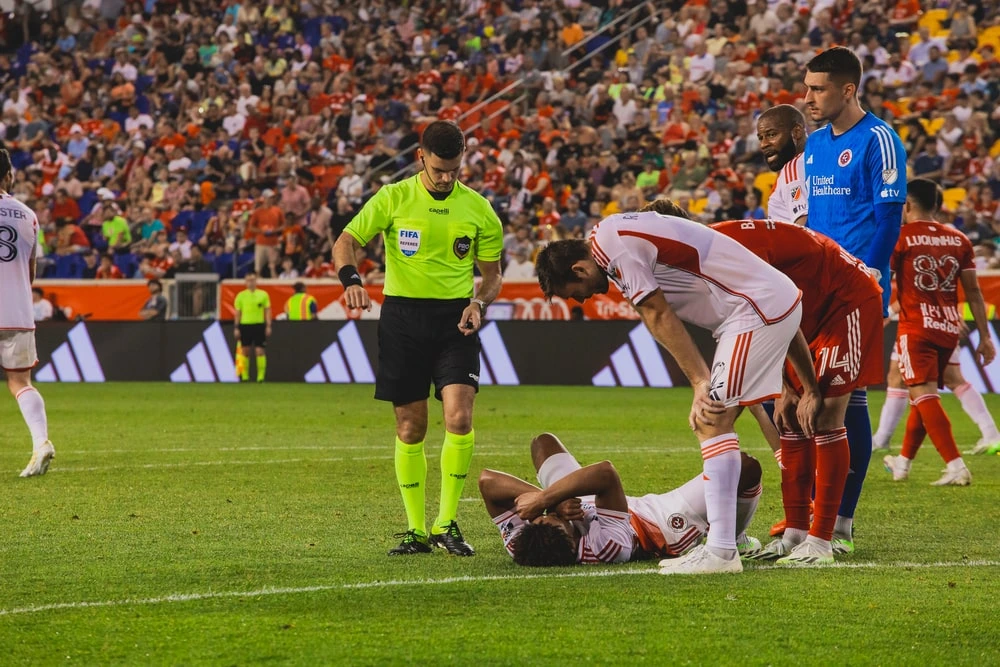Soccer is a fast-paced and exhilarating sport, but with it comes the risk of injuries. From sprained ankles to torn ligaments, soccer players are no strangers to getting hurt on the field. In this blog post, we’ll explore some of the most common soccer injuries and how you can prevent them from happening to you.
Sprains and Strains
Sprains and strains are common injuries that can occur while playing soccer. These two terms are often used interchangeably, but they actually refer to different types of injuries.
A sprain is an injury to a ligament, which is the tissue that connects bones at a joint. It happens when a ligament is stretched or torn due to sudden movements such as twisting, turning or landing awkwardly. On the other hand, a strain refers to an injury to a muscle or tendon, which connects muscles to bones. This type of injury occurs when these tissues are overused or overstretched.
Soccer players are particularly prone to sprains and strains due to the nature of the sport. The constant running, kicking and sudden changes in direction put a lot of stress on the joints and muscles, increasing the risk of these injuries.
Fortunately, there are steps that can be taken to prevent sprains and strains from occurring:
1. Warm-up properly
Before any physical activity, it’s important to warm up your body by doing some light exercises like jogging or stretching. This helps increase blood flow and makes your muscles more pliable, reducing the risk of injury.
2. Strengthen your muscles
Stronger muscles are less likely to get strained or sprained. Incorporate strength training exercises into your fitness routine targeting all major muscle groups involved in soccer such as legs, core, and upper body.
3. Use proper equipment
Wearing appropriate shoes with good ankle support can help prevent ankle sprains. Also make sure that shin guards fit snugly around your lower leg for added protection against strains caused by contact with other players‘ legs.
4. Maintain good form

When playing soccer, it’s important to maintain proper form while running and kicking the ball. Avoid excessive twisting or reaching beyond your range of motion which can lead to sprains or strains.
5. Stay hydrated
Dehydration can cause cramping in muscles making them more vulnerable to injury. Keep yourself hydrated before, during and after playing soccer.
If you do experience a sprain or strain during a game, stop playing immediately and seek medical attention. Ignoring these injuries can lead to further damage and longer recovery time. Remember to always listen to your body and pace yourself to avoid overexertion.
Broken Bones
One of the most common and potentially serious injuries in soccer is broken bones, also known as fractures. Fractures occur when there is a break or crack in the bone, and they can range from minor hairline fractures to more severe breaks that require surgery.
It is essential for coaches, players, and parents to recognize the signs of a fracture in order to provide timely and appropriate treatment. Here are some tips on how to recognize and treat fractures in soccer players:
1. Signs and Symptoms
The most obvious sign of a fracture is intense pain at the site of injury. Other symptoms may include swelling, bruising, tenderness, deformity or abnormal positioning of the affected area, and difficulty moving or putting weight on the injured limb.
2. Types of Fractures
There are different types of fractures that can occur in soccer players. An open or compound fracture happens when the broken bone punctures through the skin. A closed fracture occurs when there is no break in the skin but may still cause severe pain and swelling. Stress fractures are small cracks in the bone caused by repetitive stress.
3. First Aid
If you suspect a player has a fracture, it is crucial to immobilize them immediately by not allowing them to put any weight on the injured limb. Apply ice wrapped in a cloth or towel for 15-20 minutes every hour until medical help arrives.
4. Medical Treatment
Seeking medical attention should be your top priority if you suspect a fracture. The doctor will perform an X-ray or MRI scan to confirm the diagnosis and determine its severity.
5. Recovery Process
The recovery process for a fractured bone varies depending on its severity; however, proper treatment involves immobilization with cast or splinting for several weeks followed by physical therapy exercises to regain strength and mobility gradually.
6. Preventing Fractures

Preventing fractures in soccer players starts with proper training and conditioning. Players should be adequately warmed up before a game or practice session to prevent muscle fatigue, which can increase the risk of fractures. Also, coaches need to ensure that players are using the correct techniques while playing to reduce the impact on their bones.
Concussions
Concussions are one of the most common injuries in soccer, and they can occur to players of all ages and skill levels. Understanding the signs, symptoms, and recovery process of concussions is crucial for both players and coaches in order to prevent further injury and ensure a safe return to play.
Signs of a concussion may not always be immediately apparent, so it is important for players to be aware of any blows or jolts to the head during a game or practice. Some common signs to look out for include confusion, memory loss, dizziness or balance problems, headache, nausea or vomiting, sensitivity to light or noise, changes in mood or behavior, and loss of consciousness. It is important for players who experience any of these symptoms after a hit to the head to immediately notify their coach or medical staff.
Symptoms of a concussion can vary from person to person and may not always be obvious at first. They can also develop over time following an initial injury. Some common symptoms include headaches that worsen with physical activity, difficulty concentrating or remembering things, irritability or changes in mood, sleep disturbances such as sleeping more than usual or having trouble falling asleep, blurred vision or difficulty focusing on objects. If any player experiences these symptoms following an impact to the head during soccer activities they should seek immediate medical attention.
The recovery process for concussions varies depending on the severity of the injury and individual circumstances. In general terms though there are some key steps that all players should follow when recovering from a concussion:
1. Rest
The first step towards recovery is ensuring adequate rest for both body and mind. This means avoiding physical activity that could potentially cause another blow to the head.
2. Gradual Return
Once symptoms have resolved completely it is important for players not return too quickly back into full contact training but rather ease themselves back gradually so as not put themselves at risk again
3. Monitoring
Players should continue to be monitored by medical staff and report any symptoms or changes in how they are feeling.
4. Follow-up

It is important for players to follow up with their doctor after a concussion to ensure that the injury has fully healed, and there are no lingering effects.
ACL Tears
One of the most common and devastating injuries faced by soccer players is a tear in the anterior cruciate ligament (ACL). This injury can occur when there is a sudden change in direction, jumping or landing awkwardly, or from a direct impact to the knee. The ACL is one of four major ligaments that stabilize the knee joint, making it essential for movements such as running, kicking, and cutting.
An ACL tear can be extremely painful and often requires surgery and extensive rehabilitation. It can also have long-term consequences on a player’s career if not treated properly. That’s why it’s crucial for soccer players to understand how they can avoid this type of injury.
First and foremost, proper warm-up and stretching before any physical activity are crucial in preventing ACL tears. Warming up helps increase blood flow to your muscles, making them more flexible and less prone to injury. Incorporating dynamic stretches that mimic soccer movements into your warm-up routine can help prepare your body for the demands of the game.
1. Strength training
Maintaining strong leg muscles through regular strength training exercises is also vital in preventing ACL tears. Strong quadriceps, hamstrings, glutes, and calf muscles provide stability to the knee joint during sudden movements. It’s essential to include exercises such as squats, lunges, deadlifts, and leg presses in your workout routine.
2. Correct technique
Another important factor in avoiding ACL tears is proper technique during training and games. Coaches should ensure that all players are using correct form when performing actions like cutting or changing direction quickly. Incorrect form puts unnecessary stress on joints like the knees which increases the risk of injury.
3. Appropriate footwear
Wearing appropriate footwear with good traction is another way to prevent ACL tears on the field. Cleats with studs designed specifically for playing on turf or grass surfaces provide better grip while running or turning compared to regular athletic shoes.
4. Break
Lastly but most importantly, players should listen to their bodies and take breaks when necessary. Overtraining or playing while fatigued significantly increases the risk of ACL tears. Taking regular rest days and getting enough sleep are crucial for allowing your body to recover and prevent injury.
Conclusion
By being aware of these common soccer injuries and taking preventative measures such as proper warm-up and training techniques, players can decrease their chances of getting injured on the field. With proper precautions in place, everyone can enjoy this beloved sport without worrying about potential injuries.
FAQs
The most common soccer injuries include strains and sprains, bruises, cuts, and scrapes. Other frequent injuries are knee ligament tears, ankle sprains, and concussions.
To prevent soccer injuries, it is important to warm up properly before each game or practice session. This helps to loosen up your muscles and reduce the risk of strains and sprains. Additionally, wearing proper protective gear such as shin guards and cleats can also help prevent injuries.
Yes, stretching before playing soccer is important to improve flexibility and reduce the risk of muscle strains or tears. Stretching should be a part of your warm-up routine before any physical activity.
